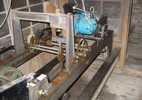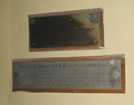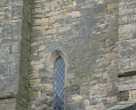For this church:    |
|
This Clock was erected by Public Subscription May 1871, Committee, Revd Robert Miles, Rector, Bingham.
Revd Nathl Keymer,
Curate. |
The clock is mounted on a cast-iron flat bed and has three gear trains (hands, hour strike and quarter chimes) and a pin escapement mechanism. When it was first installed the clock was powered, like most turret clocks of the era, by large weights which descended for most of the height of the tower and had to be laboriously wound up at least once a week.
The clock mechanism was brought to ground level for refurbishment, along with the bells, when the tower maintenance was carried out in 1922.
In 1976, as part of the 750th anniversary celebrations of the church, the clock was restored and an automatic electric winding mechanism introduced, which is still in use. Another plaque on the wall reads:
1976 |
and a small plaque on the clock mechanism itself states that the work was carried out by John Smith & Sons of Derby, though that gives the date as 1975.
When the clock had first been installed some of the oak beams supporting the ringing room floor had been cut short to make room for the weights. When the mechanism was electrified these beams were not restored. This meant that the floor was supporting the beams rather than vice versa, and the floor eventually began to show signs of weakness. It had to be strengthened in 2003.
The clock is located on the top level of the tower. This is rather unusual in that it places it above the level of the bells. This naturally gives it greater visibility, but leads to certain complications in connecting to the bells for the chimes. When the clock was first installed there was only a ring of six bells, and certain shortcuts were taken in connecting the clock to the bells. This means that one of the chiming hammers is on the “wrong” bell, and the Westminster Chimes sound out of tune.
The clock faces were originally painted black, but in 1976 they were repainted using a very pale blue. The painting was carried out by a man lowered from the tower parapet on the top of a kitchen table suspended by ropes. The change of colour led to far more controversy than any health and safety implications of the painting method!
A few years ago the faces were again showing signs of deterioration and, with help from the Friends of Bingham Parish Church and the wider community, in 2008 they were repainted in a deeper blue, and the figures and hands regilded. This time the workmen used a more conventional access method!
There are known to have been other clocks in the church tower before the current one. In 1775 a lightning bolt struck the tower and damaged the clock. In addition there is a line drawing of the church by Samuel Hieronymus Grimm and dating from around 1775 which shows a lozenge-shaped structure about half-way up the tower which looks very like a clock face. This is also visible on Throsby’s drawing of the 1790s. It is just possible to make out a patch on the wall of the tower (to the top right of one of the current windows) would could have been the site of this former clock.
There is also a painting of the church dating from 1855. This shows a clock face on the south side of the tower in much the same position as one of the current clock faces; there is, however, no clock face shown on the western side. This suggests that the current clock may be the third clock to have been in Bingham church tower.














